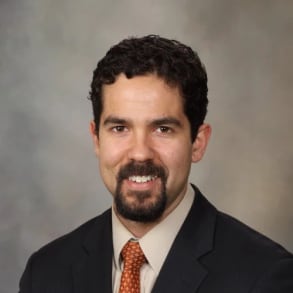Gavin W. Roddy, M.D., Ph.D., is an ophthalmologist who specializes in glaucoma at Mayo Clinic in Rochester, Minnesota. In this video, a patient with advanced glaucoma who was experiencing visual field deficits receives a Baerveldt drainage device in order to lower intraocular pressure. Watch as Dr. Roddy performs a left Baerveldt-350 glaucoma drainage device implantation with cornea patch graft.
Today we're gonna be taking care of a 62 year old male who has advanced glaucoma. We have offered him a tube a bear belt, 350 glaucoma. Strange device in order to lower his intraocular pressure. So we're replacing a bare Veldt tube in order to place the two. We're gonna obtain exposure by opening four millimeters back from the limb bas because we placed the wings of the bare Veldt tube under the muscles. We're going to isolate the superior and lateral rectus And then we isolate the muscle using a 40 silk suture. Now we turn our attention to the lateral rectus and using a four oh silk, you tie off the muscle. So even though this is a non valved tube, I still flush the tube just to confirm that the tube is functioning properly. Take the 60. Vicryl to tie off the tube and then by flushing the tube with bss, we ensure that the tube is in fact tied off. So now we're ready to place the plate and we tuck the wings under the muscles that have already been isolated on a four oh silk suture. So then we rotate the eye infra nasally to expose the superior temporal quadrant. Or we're going to be securing the plate to the globe So the plate is going to be secured 10 back from the lymphocytes. We make our marks pass suture to secure the plate to the globe. So with the plate secure to the globe, we're ready to assess the position of the tube as it enters the eye. We put a bevel an anterior bevel on the tube and the tube will be placed under Helen to allow posterior placement of the tube just over the iris plane. So in addition to patch graft, I do a scleral tunnel to protect the tomb from erosion. So we make a squirrel tunnel before diving posteriors. We have nice posterior placement of the tube and we enter the A. C. Far away from the cornea. So with Helen out of the eye, we can confirm proper placement of the tube just over the iris and parallel with the iris. So we're going to secure the tube to the square A using a 90. Vicryl suture because this tube is tied off with a vicryl suture. We actually need to provide a little pressure reduction in the early postoperative period. So we're going to perform a feminist rations that will provide some flow until that vicryl suture naturally breaks at about six weeks post op and to reduce the risk of exposure through the content. Even over time, we use a cornea patch graft to cover the length of the tube. So with the tube in position in the A. C. Iris plane and the tube covered by the cornea patch crap in the administration center in place. We're now ready to close. Okay, so the content type is closed and the tube is in great position and the super temporal quadrant just over the iris. Okay

